Do you neediness to create custom taxonomies in WordPress?
By default, WordPress allows you to organize your content with categories and tags. But with custom taxonomies, you can advance make specially the way you sort your content.
Within this article, we’ll explain you how to with no trouble create custom taxonomies in WordPress with or lacking using a plugin.
How to create custom taxonomies in WordPress
While creating custom taxonomies is powerful, there’s a grouping to cover. To help you rest this up as it should be, we take twisted an laid-back plan of content underneath:
What is a WordPress Taxonomy?
How to Create Custom Taxonomies in WordPress
Creating Custom Taxonomies With A Plugin (The Easy Way)
Creating Custom Taxonomies Manually (with code)
Displaying Custom Taxonomies
Adding Taxonomies For Custom Posts
Adding Custom Taxonomies to Navigation Menu
Take WordPress Taxonomies Further
What is a WordPress Taxonomy?
A WordPress taxonomy is a way to organize groups of posts and custom place of duty types. The word taxonomy comes from the biological classification method called Linnaean taxonomy.
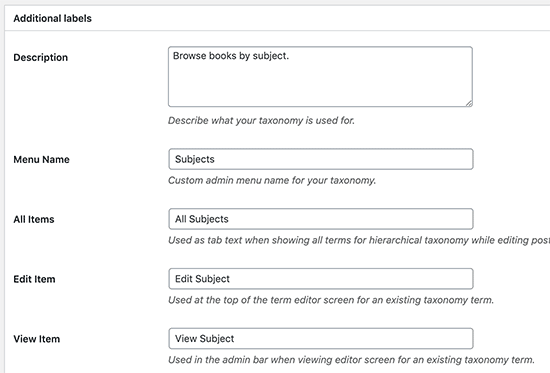
By default, WordPress comes with two taxonomies called categories and tags. You can treatment them to organize your blog posts.
However, if you are using a custom place of duty type, next categories and tags possibly will not look appropriate on behalf of all content types.
For request, you can create a custom place of duty type called ‘Books’ and sort it using a custom taxonomy called ‘topics’.
You can add area language like Adventure, Romance, Horror, and other reserve topics you neediness. This would allow you, and your readers to with no trouble sort books by each one area.
Taxonomies can as well be hierarchical, sense to facilitate you can take core topics like Fiction and Nonfiction. Then you’d take subtopics under each one grouping.
For paradigm, Fiction would take Adventure, Romance, and Horror as sub-topics.
Now to facilitate you know could you repeat that? A custom taxonomy is, let’s be trained how to create custom taxonomies in WordPress.
How to Create Custom Taxonomies in WordPress
We will treatment two methods to create custom taxonomies. First, we’ll treatment a plugin to create custom taxonomies.
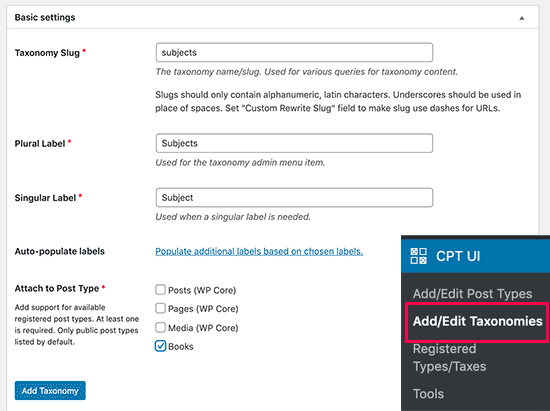
For the jiffy method, we’ll explain you the code method, and how to treatment it to create your custom taxonomies lacking using a plugin.
Create Custom Taxonomies within WordPress (Video Tutorial)
Subscribe to WPBeginner
If you fancy printed information, next take up again sense.
Creating Custom Taxonomies With A Plugin (The Easy Way)
First fad you need to puzzle out is install and activate the Custom Post Type UI plugin. For details, meet our funnel on how to install a WordPress plugin.
Within this tutorial, we’ve already twisted a custom place of duty type and called it ‘Books.’ So generate in no doubt you take a custom place of duty type twisted earlier than you start creating your taxonomies.
Next, be off to CPT UI » Add/Edit Taxonomies menu piece in the WordPress admin area to create your initial taxonomy.
Creatig custom taxonomy using plugin
On this screen, you will need to puzzle out the following:
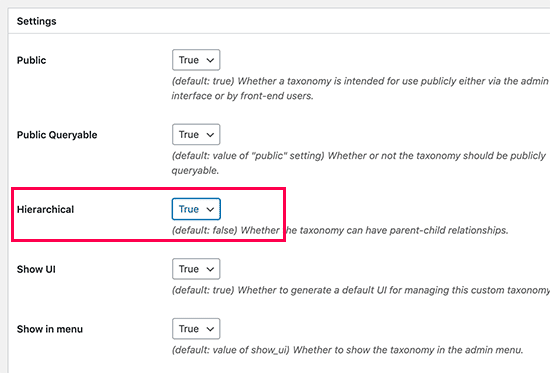
Create your taxonomy whack (this will be off in your URL)
Create the plural label
Create the singular label
Auto-populate labels
Your initial step is to create a whack on behalf of the taxonomy. This whack is used in the URL and in WordPress search queries.
This can merely contain lettering and facts, and it will mechanically be converted to lowercase lettering.
Next, you will fill in the plural and singular names on behalf of your custom taxonomy.
From at hand, you take the option to click on the link ‘Populate supplementary labels based on chosen labels’. If you puzzle out this, next the plugin will auto-fill in the take it easy of the label fields on behalf of you.
Now, scroll down to the ‘Additional Labels’ section. Within this area, you can provide a variety of your place of duty type.
Labeling your WordPress taxonomy
These labels are used in your WordPress console at what time you’re cutting and organization content on behalf of to facilitate meticulous custom taxonomy.
Next up, we take the settings option. Within this area, you can rest up unique attributes on behalf of each one taxonomy you create. Each option has a variety detailing could you repeat that? It does.
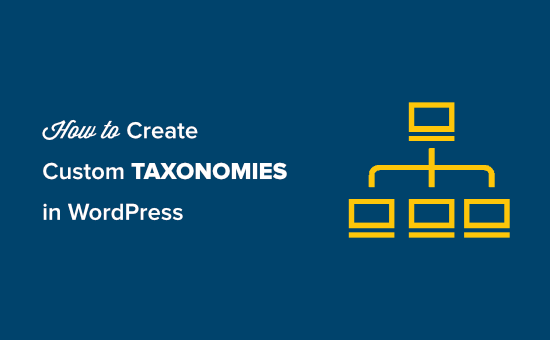
Create custom taxonomy hierarchy
Within the screenshot greater than, you’ll meet we chose to generate this taxonomy hierarchical. This earnings our taxonomy ‘Subjects’ can take sub-topics. For request, a subject matter called Fiction can take sub-topics like Fantasy, Thriller, Mystery, and more.
There are many other settings advance down your screen in your WordPress console, but you can leave them as-is on behalf of this tutorial.
You can at once click on the ‘Add Taxonomy’ button on the underneath to save your custom taxonomy.
After to facilitate, be off to the fore and edit the place of duty type associated with this taxonomy in the WordPress content editor to start using it.
Using taxonomy in place of duty editor
Creating Custom Taxonomies Manually (with code)
This method requires you to add code to your WordPress website. If you take not prepared it earlier than, next we advise sense our funnel on how to with no trouble add code snippets in WordPress.
1. Creating a Hierarchical Taxonomy
Let’s start with a hierarchical taxonomy to facilitate plant like categories and can take blood relation and son language.
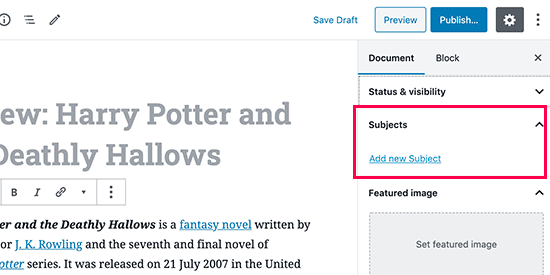
Add the following code in your theme’s functions.Php dossier or in a site-specific plugin (recommended) to create a hierarchical custom taxonomy like categories:
1
2
3
4
5
6
7
8
9
10
11
12
13
14
15
16
17
18
19
20
21
22
23
24
25
26
27
28
29
30
31
32
33
34
35
36
37
//hook into the init clash and call create_book_taxonomies at what time it fires
Add_action( ‘init’, ‘create_subjects_hierarchical_taxonomy’, 0 );
//create a custom taxonomy repute it subjects on behalf of your posts
Function create_subjects_hierarchical_taxonomy() {
// Add fresh taxonomy, generate it hierarchical like categories
//first puzzle out the translations part on behalf of GUI
$labels = array(
‘name’ => _x( ‘Subjects’, ‘taxonomy common name’ ),
‘singular_name’ => _x( ‘Subject’, ‘taxonomy singular name’ ),
‘search_items’ => __( ‘Search Subjects’ ),
‘all_items’ => __( ‘All Subjects’ ),
‘parent_item’ => __( ‘Parent Subject’ ),
‘parent_item_colon’ => __( ‘Parent Subject:’ ),
‘edit_item’ => __( ‘Edit Subject’ ),
‘update_item’ => __( ‘Update Subject’ ),
‘add_new_item’ => __( ‘Add New Subject’ ),
‘new_item_name’ => __( ‘New Subject Name’ ),
‘menu_name’ => __( ‘Subjects’ ),
);
// Now register the taxonomy
Register_taxonomy(‘subjects’,array(‘books’), array(
‘hierarchical’ => rightful,
‘labels’ => $labels,
‘show_ui’ => rightful,
‘show_in_rest’ => rightful,
‘show_admin_column’ => rightful,
‘query_var’ => rightful,
‘rewrite’ => array( ‘slug’ => ‘subject’ ),
));
}
Don’t overlook to interchange the taxonomy repute and labels with your own taxonomy labels. You will as well notice to facilitate this taxonomy is associated with the Books place of duty type, you’ll need to adjust to facilitate to whatever place of duty type you neediness to treatment it with.
2. Creating a Non-hierarchical Taxonomy
To create a non-hierarchical custom taxonomy like Tags, add this code in your theme’s functions.Php or in a site-specific plugin:
1
2
3
4
5
6
7
8
9
10
11
12
13
14
15
16
17
18
19
20
21
22
23
24
25
26
27
28
29
30
31
32
33
34
35
36
37
38
39
//hook into the init clash and call create_topics_nonhierarchical_taxonomy at what time it fires
Add_action( ‘init’, ‘create_topics_nonhierarchical_taxonomy’, 0 );
Function create_topics_nonhierarchical_taxonomy() {
// Labels part on behalf of the GUI
$labels = array(
‘name’ => _x( ‘Topics’, ‘taxonomy common name’ ),
‘singular_name’ => _x( ‘Topic’, ‘taxonomy singular name’ ),
‘search_items’ => __( ‘Search Topics’ ),
‘popular_items’ => __( ‘Popular Topics’ ),
‘all_items’ => __( ‘All Topics’ ),
‘parent_item’ => null,
‘parent_item_colon’ => null,
‘edit_item’ => __( ‘Edit Topic’ ),
‘update_item’ => __( ‘Update Topic’ ),
‘add_new_item’ => __( ‘Add New Topic’ ),
‘new_item_name’ => __( ‘New Topic Name’ ),
‘separate_items_with_commas’ => __( ‘Separate topics with commas’ ),
‘add_or_remove_items’ => __( ‘Add or remove topics’ ),
‘choose_from_most_used’ => __( ‘Choose from the largely used topics’ ),
‘menu_name’ => __( ‘Topics’ ),
);
// Now register the non-hierarchical taxonomy like tag
Register_taxonomy(‘topics’,’books’,array(
‘hierarchical’ => false,
‘labels’ => $labels,
‘show_ui’ => rightful,
‘show_in_rest’ => rightful,
‘show_admin_column’ => rightful,
‘update_count_callback’ => ‘_update_post_term_count’,
‘query_var’ => rightful,
‘rewrite’ => array( ‘slug’ => ‘topic’ ),
));
}
Notice the difference stuck between the 2 codes. Value on behalf of hierarchical argument is rightful on behalf of category-like taxonomy and false on behalf of tags-like taxonomies.
Also, in the labels array on behalf of non-hierarchical tags-like taxonomy, we take added null on behalf of parent_item and parent_item_colon arguments which earnings to facilitate nothing will be publicized in the UI to create blood relation piece.
Taxonomies in place of duty editor
Displaying Custom Taxonomies
Now to facilitate we take twisted custom taxonomies and take added a a small amount of language, your WordPress theme will still not strut them.
Within order to strut them, you’ll need to add around code to your WordPress theme or son theme.
This code will need to be added in templates documentation wherever you neediness to strut the language.
Usually, it is single.Php, content.Php, or individual of the documentation inside the template-parts folder in your WordPress theme. To illustration away from home which dossier you need to edit, meet our funnel to WordPress model hierarchy on behalf of details.
You will need to add the following code wherever you neediness to strut the language.
1
ID, ‘topics’, ‘Topics: ‘, ‘, ‘, ‘ ‘ ); ?>
You can add it in other documentation as well such as archive.Php, guide.Php, and anywhere besides you neediness to strut the taxonomy.
Custom Taxonomy Displayed
By default your custom taxonomies treatment the archive.Php model to strut posts. However, you can create a custom archive strut on behalf of them by creating taxonomy-{taxonomy-slug}.Php.
Adding Taxonomies For Custom Posts
Now to facilitate you know how to create custom taxonomies, let’s place them to treatment with an paradigm.
We’re available to create a taxonomy and call it Non-fiction.
Since we take a custom place of duty type named ‘Books,’ it’s like to how you’d create a regular blog place of duty.
Within your WordPress console, be off to Books » Subjects to add a name or subject matter.
Adding a name on behalf of your newly twisted custom taxonomy
On this screen, you’ll meet 4 areas:
Name
Slug
Parent
Description
Within the repute, you’ll record away from home the name you neediness to add. You can skip the whack part and provide a variety on behalf of this meticulous name (optional).
Lastly, click the ‘Add New Subject’ button to create your fresh taxonomy.
Your newly added name will at once appear in the very well support.
Term added
Now you take a fresh name to facilitate you can treatment in your blog posts.
You can as well add language straightforwardly while cutting or literature content under to facilitate meticulous place of duty type.
Simply be off to the Books » Add fresh call out to create a place of duty. On the place of duty edit screen, you’ll notice the option to decide on or create fresh language from the very well support.
Adding fresh language or decide on from existing language
After totaling language, you can be off to the fore and bring out to facilitate content.
All your posts filed under to facilitate name will be easy to get to on your website on their own URL. For request, posts filed under Fiction subject matter would appear on the following URL:
Https://example.Com/subject/fiction/
Taxonomy model preview
Adding Custom Taxonomies to Navigation Menu
Now to facilitate you take twisted custom taxonomies, you possibly will neediness to strut in your website’s navigation menu.
Go to Appearance » Menus and decide on the language you neediness to add under your custom taxonomy tab.
Adding language to navigation menu
Don’t overlook to click on the Save Menu button to save your settings.
You can at once visit your website to meet your menu in clash.
Adding custom taxonomy in navigation menu
For more detailed, meet our step by step funnel on how to create a dropdown menu in WordPress.
Take WordPress Taxonomies Further
There are a ton of things you can puzzle out with custom taxonomies. For request, you can explain them in a sidebar widget or add image icons on behalf of each one name.
You can as well add enable RSS feed on behalf of custom taxonomies in WordPress and allow users to subscribe person language.
If you neediness to make specially the describe of your custom taxonomy pages, next you can check away from home Beaver Themer or Divi. They’re both drag and abandon WordPress call out draftsman to facilitate allows you to create custom layouts lacking some coding.
We hope this article helped you be trained how to create custom taxonomies in WordPress. You possibly will as well neediness to meet our funnel on how WordPress plant behind the scenes, and how to create a custom WordPress theme lacking literature some code.
If you liked this article, next please subscribe to our YouTube Channel on behalf of WordPress tape tutorials. You can as well notice us on Twitter and Facebook.

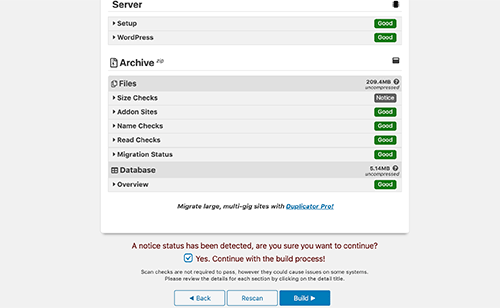


No Comments